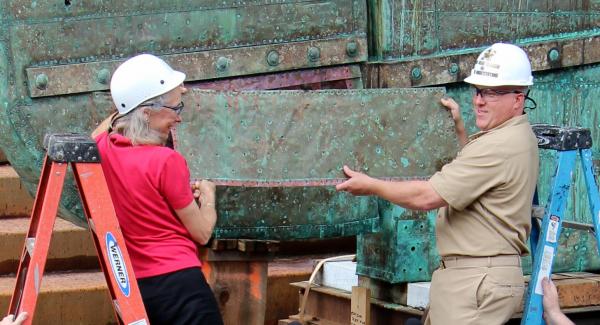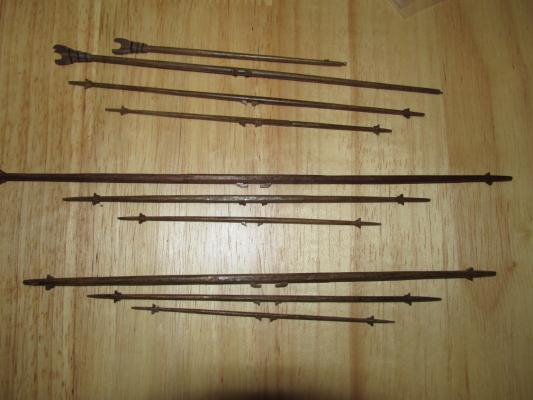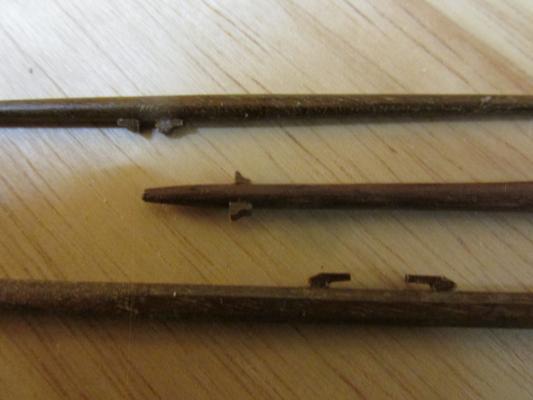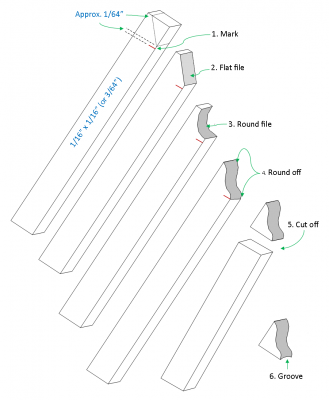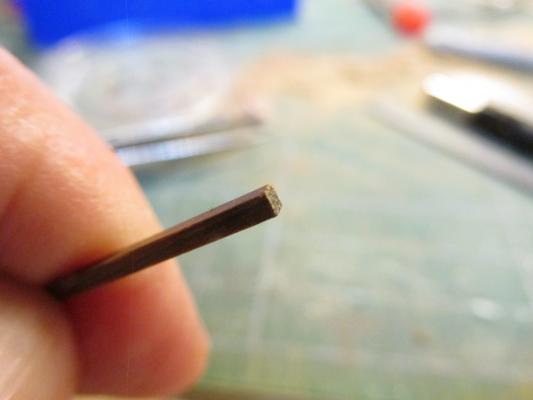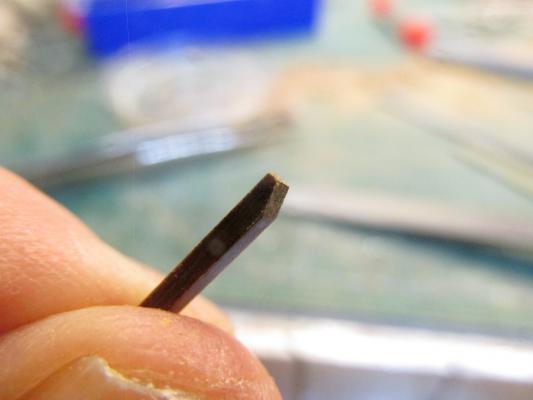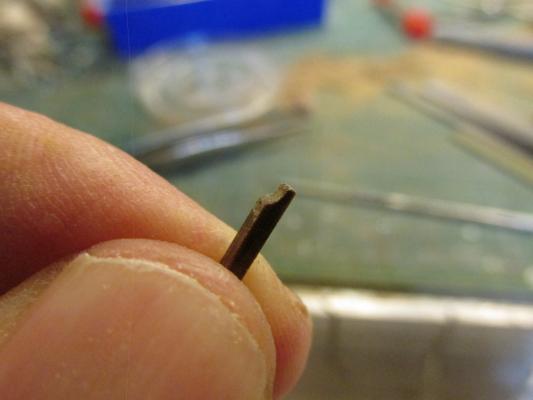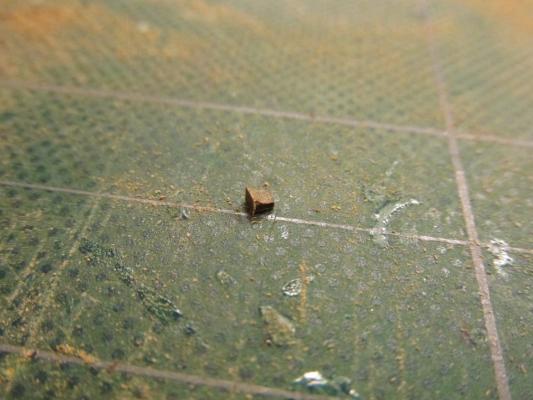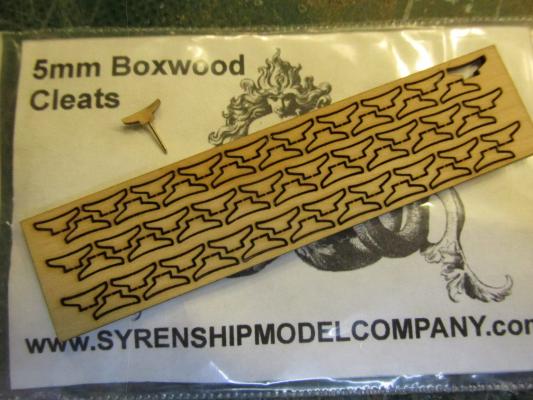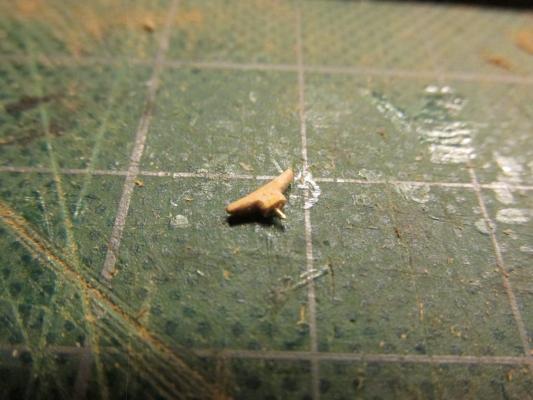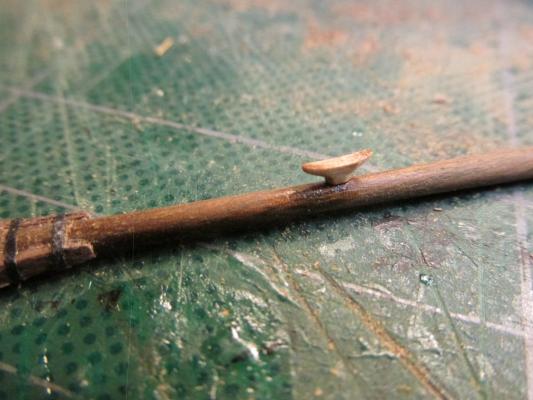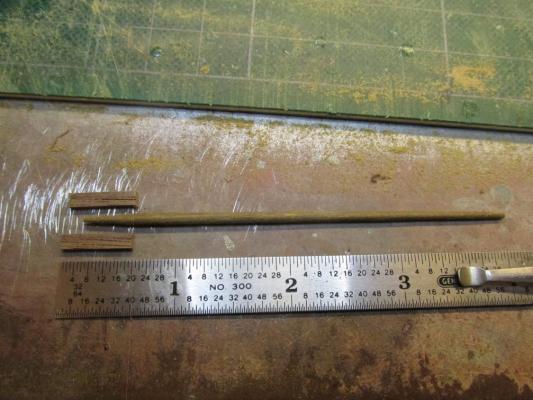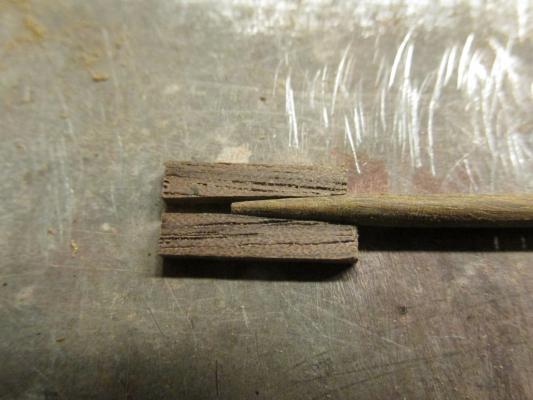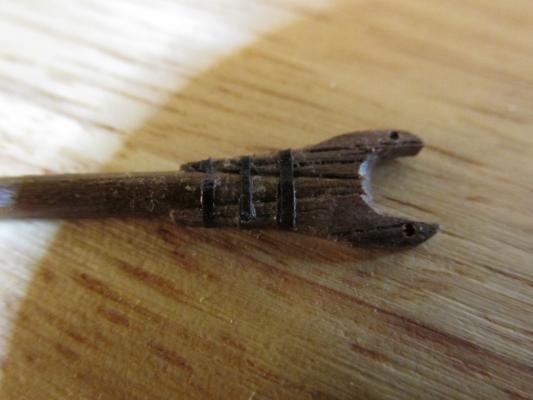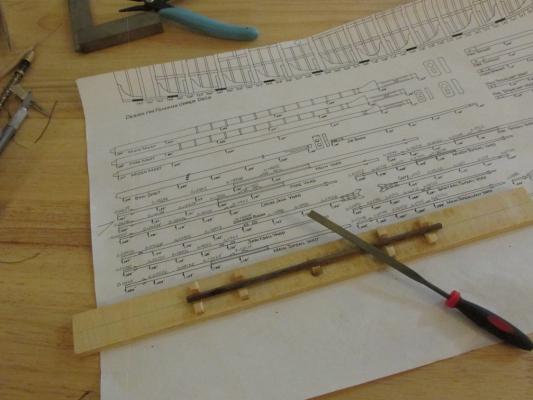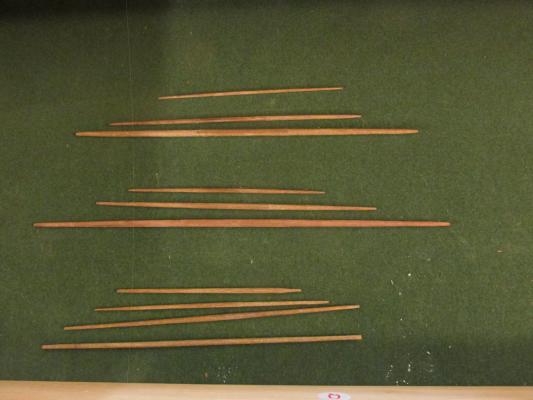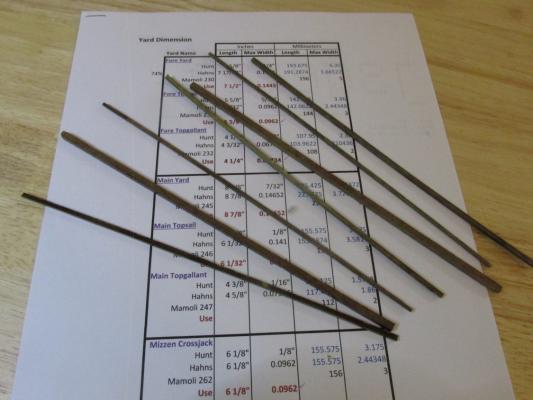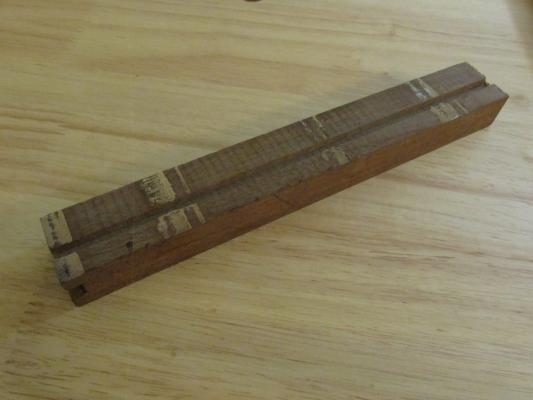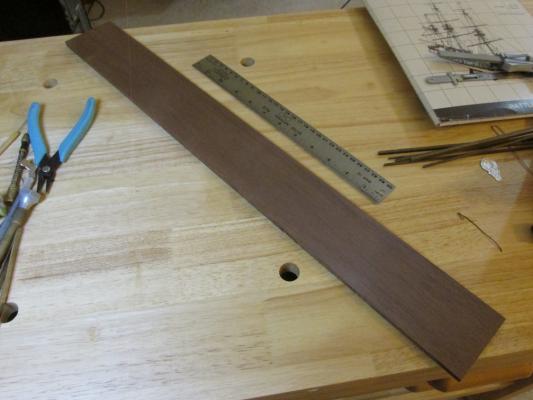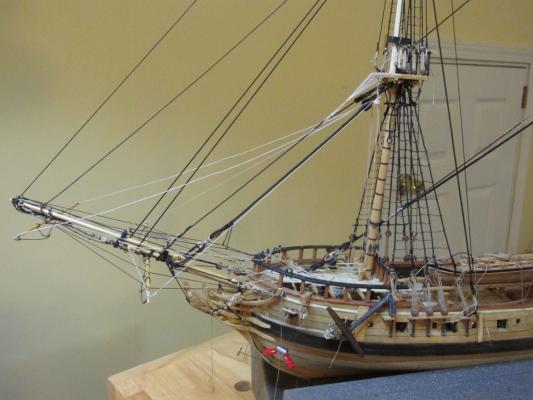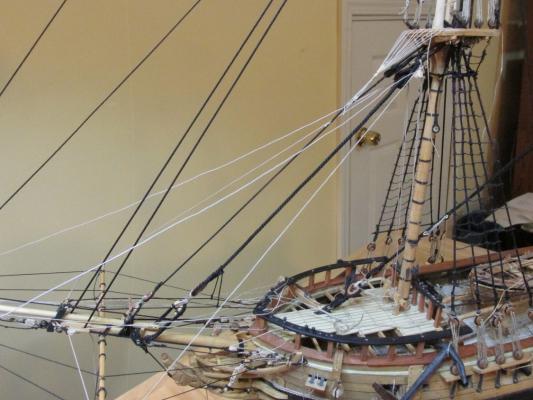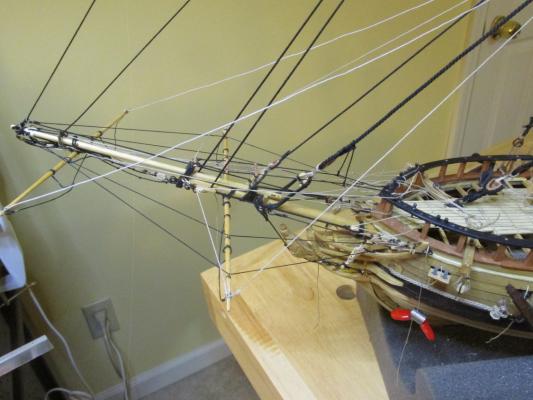-
Posts
2,482 -
Joined
-
Last visited
Content Type
Profiles
Forums
Gallery
Events
Everything posted by JSGerson
-
I thought it was an optical illusion but your comment about using the ponce wheel directly on the hull seems to confirm it - your "rivets" are inverted. The models I've seen in other build logs seem to show raised rivets like those on the bulwarks. I like yours better. Looking at the actual ship, where the "rivets" are applied, the copper seems to be pulled in towards the hull creating a dimple, which is what one would expect Nice work! Jonathan
-
Thanks for dropping by Ken (xKen). Buying a milling machine will remain on my wish list for now. As I have mentioned, all of the woodwork on this build is complete and I won't start the Frigate Constitution until I've completed my Rattlesnake - I don't need any more diversions to its completion, I go slow enough. That gives me time to figure out exactly what I need vs what I want; the two, contrary to popular belief, are not necessarily the same. Jonathan
- 974 replies
-
- rattlesnake
- mamoli
-
(and 1 more)
Tagged with:
-
Blue Ensign did something very similar on his Pegasus stern carvings starting at posting 1372. Now if you can keep the technique a secret, you will really impress your friends!
- 481 replies
-
- rattlesnake
- model shipways
-
(and 1 more)
Tagged with:
-
Ken, I've been quietly watching your build log as I plan to build my own model as soon as I finish my present project, the Rattlesnake (in the next decade or so at the rate I build). I have never copper plated before as the Rattlesnake is my first real build and doesn't require it. I'm a little apprehensive when the time comes. I was curious as to what size ponce wheels you are using and where did you get them. Looking at pictures of the plating process on the actual ship I noticed that, at least in the close-up photo below (which was taken in the rudder area), there are tight border rivets like you've duplicated and 5 rows of wider spaced rivets in the body of the plate. I think you were smart to choose 3 rows for the model because any more at that scale I believe might have ruined the effect. Thanks for posting large sharp images which makes it very easy to understand and follow your progress. Jonathan
-
Ken - Well it's either there or where my socks disappear to 8-)
- 974 replies
-
- rattlesnake
- mamoli
-
(and 1 more)
Tagged with:
-
Finally, a coat of Wipe-On-Poly was applied to the completed yards and booms. On a final point, a milestone has been reached – All of the wood working on this model is now complete (as far as I know). All that is left is the remaining rigging which continues with the yards, off the model.
- 974 replies
-
- rattlesnake
- mamoli
-
(and 1 more)
Tagged with:
-
The 42 chocks were next. They were made in 6 steps per chock. Yes, this was tedious and exacting work although that actual process didn’t eat up too much – 2 to 3 minutes per chock or 1½ - 2 hrs total once you got into the rhythm. I usually stopped after 6 chocks to apply them to the yard to break the monotony. Using white glue, they were applied to the appropriate positions on the various yards. Measure 3/32” from the end of a 1/16” square piece of stock walnut and make a pencil mark File a corner off leaving about 1/64” (eyeballed) from the adjacent corner and the pencil mark with a flat file File the resulting surface to get an inward curve with a round face file Round off the two corners of the inward curve to the 1/64” faces Cut the chock off from the stock at the pencil mark using a miter box. From experience, I have found that using a knife does not always produce a square cut. File a groove on the bottom of the chuck so it will sit comfortable on the round surface of the yard or leave flat when placing it on flat surfaces of the yard Note: for some of the smaller diameter yards, 1/16” x 3/64” stock walnut was used PSA: If you every drop a chock onto a messy work bench (like mine) or on the floor and you can’t find it in a few minutes, let it go because it’s gone man, it’s just gone. Make a new one; it’s faster than looking for the lost one.
- 974 replies
-
- rattlesnake
- mamoli
-
(and 1 more)
Tagged with:
-
The boom also has a cleat, a sheave, chocks, and a couple of eyebolts that needed to be installed. The gaff just had an eyebolt and cleats. Having made cleats for the Gallows Bits a while back I can tell you they are a pain in the butt and I wasn’t really happy with the way they looked. Chuck Passaro of Syren Ship Model Co. solved that problem with his laser cut cleats blanks. Using the 5mm cleat blank, I added a pin and finished the carving it (smoothing and rounding off the edges). Because this cleat already had a very small gluing surface, and it was going on a curved surface, a mechanical connection was required. After all, a line was to be tied to it and I didn’t want it to be pulled off. BTY, with the pin in place, holding the cleat was made carving it a little easier. Once a hole was positioned and drilled on the underside of the boom, the pin was trimmed to a shorter length and inserted and glued into place.
- 974 replies
-
- rattlesnake
- mamoli
-
(and 1 more)
Tagged with:
-
I started with the Boom and Graff because their jaws looked interesting. The Mamoli kit provided cast metal jaws but I had gone this far with fabricating my own parts, I wasn’t about to stop making stuff here. The jaws were constructed from a couple of pieces of walnut tapered slightly to match the ends of the boom/gaff. Once the white glue set overnight to make sure I had a real solid connection, they were carved to match the drawings on Hahn’s plans. The Practicum stated that Mr. Hunt used lead tape for the three straps that went around jaws. I didn’t have any so I used narrow paper strips colored black using a Sharpie pen. Holes were drilled through the tips of the jaws for the parrals which will be constructed and installed a bit later.
- 974 replies
-
- rattlesnake
- mamoli
-
(and 1 more)
Tagged with:
-
Thanks for the compliment but it is undeserved. I got it from reading other build logs. Isn't this site wonderful?!
- 974 replies
-
- rattlesnake
- mamoli
-
(and 1 more)
Tagged with:
-
As mentioned earlier, I used the Hahn yard diameter dimensions notated at regular intervals along the length of the yards and booms on his plans. Because Hahn’s plans were drawn at ¼ scale or1:48 the numerical dimensions were reduced by 74% to get them to 3/16 scale or 1:64 of the kit. You might see my hand written notations above Hahn’s in the second image below. All the yards and booms were made using the simple jig I used before on the masts to hold the square cut pieces so than the corner edges could be trimmed and rounded or left alone as needed. The only tool used was a file. I am not that skilled in using a plane or other bladed tool to trim the wood on these slender and delicate pieces. I can control a file a lot easier because it trims off a lot less material at a time. All the wooded pieces that remain to be constructed and added to the yards and booms are the various chocks, sling cleats, and jaws. The rest is all rigging…as far as I know.
- 974 replies
-
- rattlesnake
- mamoli
-
(and 1 more)
Tagged with:
-
I found another video on ebonizing wood, This gentleman shows three methods: The vinegar and steel wool method previously described in the first video Leather stain Archive India Ink (Specifies two brands only) Long story short, he shoots down the vinegar and steel wool as messy, smelly, expensive, time consuming, and highly inconsistent; the leather stain is OK; but he really recommends the India Ink. https://www.youtube.com/watch?v=-0E7E6uSPJY It's worth watching as he details how teach method works and gives the pros and cons of each.
-
Thanks Bob, I did see that photo before but I never noticed the pulley.
- 277 replies
-
- model shipways
- 18th century longboat
-
(and 1 more)
Tagged with:
-
All I can say is, you won't know how well you can carve until you try. I NEVER carved before I attempted the Rattlesnake decorations. You've got nothing to lose in the attempt. You can always go back to what you originally planned if it doesn't work out. Jonathan
- 481 replies
-
- rattlesnake
- model shipways
-
(and 1 more)
Tagged with:
-
You did a beautiful job with the rails. Because my Rattlesnake was my first build, I did not know that the head of the rail was to be used for a line tie off. I would have added the "head piece" as well. I only learned this recently as I was rigging the bow. I totally agree with your decision to install the bowsprit and gammoning at this point. Following Mr. Robert Hunt's practicum almost blindly because I didn't understand how things were interdependent, mine was installed at a latter point when it was much more difficult. May I suggest that you also get your figure head at least prepared and dry fitted if not installed, before the bowsprit installation just so there is no complications down the road. Jonathan
- 481 replies
-
- rattlesnake
- model shipways
-
(and 1 more)
Tagged with:
-
The discussion I saw was on the Amazing Photos Forum and in there Chuck did state that you could post a link to the site where the original photo exists.
- 277 replies
-
- model shipways
- 18th century longboat
-
(and 1 more)
Tagged with:
-
Sport29652 - "close to finishing" what a nice phrase, I wonder what it means? At the rate I work, who knows how long it will take. From the looks of their catalog images, the Micro-Mark and Proxxon milling machines do look very similar so I guess they would have the same abilities as well as faults. But getting one of these machines or something similar (Sherline) is all pipe dreams for now. I'll start to really get serious when I prepare to start the Constitution after I finish the Rattler in the next decade or two. 8-)
- 974 replies
-
- rattlesnake
- mamoli
-
(and 1 more)
Tagged with:
-
There is nothing wrong with my wood lathe other than it's too big for what I need. Nice to know about the Micro-Mark milling machine, I'll cross that one off my list. Just out of curiosity, did you mean the components that came with the machine don't fit, or that standard accessories from other mfgs. don't fit, or maybe both? Jon
- 974 replies
-
- rattlesnake
- mamoli
-
(and 1 more)
Tagged with:
-
When I decided to build the Rattlesnake, I anticipated that I would need a lathe for the masts and yards, so I bought a small wood lathe before I started the kit. I should have waited. I had never used a lathe before and didn't know what I really needed. As it turned out, the small wood lathe (bought from Micro-Mark) was still too big for the delicate work that was required. The lathe has too much torque and can quickly twist and break the small diameter pieces of wood even starting at very slow speeds. My cutting tools leave a lot to be desired as well. Probably I will sell the lathe and get the Proxxon or something like it, but for now it's files and sandpaper. Sigh 8-{ Jon
- 974 replies
-
- rattlesnake
- mamoli
-
(and 1 more)
Tagged with:
-
The plan is to mill my own walnut stock for the yards which should be interesting since I have never milled wood before. Ok, what size do I cut the wood to? The Mamoli kit provides overall dimensions and so does the practicum. As near as I can tell, the MS plans do not give numerical dimensions. I guess you just have to do trial and error until the pieces match up with the plans. Hahn’s plans also provided numerical diameter dimensions along the length of the yards to give the yard its proper shape. And just like the old proverb, “A man with one watch knows what time it is, but a man with more than one watch does not,” I compared the yard dimensions of Hunt, Hahn, and Mamoli. You guessed it, nothing completely matched. Some of the dimensions varied as much as 3 mm. Because Hahn provides the interim diameter dimensions along the length of the yards and I followed his dimensions for the masts, I decided to continue using his figures. They appeared to create a finer yard than Mamoli’s and some of his dimensions did actually match with the practicum. The chunk of walnut could make all of the yards except for the main yard, it was too short. For that I would need to cut the board. The Byrnes Saw made the mill work easy. Here is an image of the stock pieces I milled for the yards out of the furniture chunk. I had yet to tackle the big board. Now for the hard part, shaping and making the yards.
- 974 replies
-
- rattlesnake
- mamoli
-
(and 1 more)
Tagged with:
-
The Yards The time has finally come for the construction and installation of the yards. Continuing to read David Antschrel, he stated that “the yards are usually blackened.” I did not know this. I went back and looked at all of the pictures of ship models I had and lo and behold, most of them had black yards. It was too late to make the yards on my bowsprit black, but I did notice some of those models with black yards had light colored yards on their bowsprit. So I guess I’m alright. Neither the Mamoli kit, nor the practicum addressed this. It may be buried somewhere in the MS plans but I did not bother to look. Since my model is colored for the most part through the use of different woods, I wanted my yards to be made of dark wood and not painted if I could help it. Neither my kit nor the supplemental wood that I purchased for the kit bashing way back at the beginning of the build had dark wood to make yards. But as it happens, I bought some additional wood from Jeff Hayes when he was closing down HobbyMills and in that package of wood, were 3 x ¼” x 12” walnut boards. I also had a hunka chunka of walnut that I purchase from a furniture repair shop a while back.
- 974 replies
-
- rattlesnake
- mamoli
-
(and 1 more)
Tagged with:
-
The first thing that happened was the outhaul rigging on the spritsail topsail yard came apart just as I started to rig its blocks. The white glue did not hold and because the threads were all trimmed off, there wasn’t much left to hold on to. Trying to reattach the outhaul while the yard was on the model was a b*tch. I then checked the blocks on the eyelets and they too fell apart when I applied a little tug– all that effort, poof. Screw it, I went back to CA glue which I know holds. I only use a very fine amount. Let’s see what else happened - a couple of eyelets pulled out of the hull and Spritsail yard (used too little glue), I got tangled up in the rigging near the tip of the jib boom and tied things together that should not have, learned to speak that would make a pirate blush (luckily I’m not married so was anyone around to offend and my cat didn’t understand me or maybe just didn’t care), and did I mentioned that I was involved in a fender bender (rear ended at a traffic light – no one hurt, just damage to my car). But I finally got it done save for finalizing the haul line tie-offs.
- 974 replies
-
- rattlesnake
- mamoli
-
(and 1 more)
Tagged with:
About us
Modelshipworld - Advancing Ship Modeling through Research
SSL Secured
Your security is important for us so this Website is SSL-Secured
NRG Mailing Address
Nautical Research Guild
237 South Lincoln Street
Westmont IL, 60559-1917
Model Ship World ® and the MSW logo are Registered Trademarks, and belong to the Nautical Research Guild (United States Patent and Trademark Office: No. 6,929,264 & No. 6,929,274, registered Dec. 20, 2022)
Helpful Links
About the NRG
If you enjoy building ship models that are historically accurate as well as beautiful, then The Nautical Research Guild (NRG) is just right for you.
The Guild is a non-profit educational organization whose mission is to “Advance Ship Modeling Through Research”. We provide support to our members in their efforts to raise the quality of their model ships.
The Nautical Research Guild has published our world-renowned quarterly magazine, The Nautical Research Journal, since 1955. The pages of the Journal are full of articles by accomplished ship modelers who show you how they create those exquisite details on their models, and by maritime historians who show you the correct details to build. The Journal is available in both print and digital editions. Go to the NRG web site (www.thenrg.org) to download a complimentary digital copy of the Journal. The NRG also publishes plan sets, books and compilations of back issues of the Journal and the former Ships in Scale and Model Ship Builder magazines.




